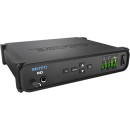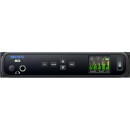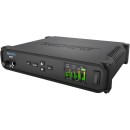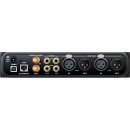MOTU 8D 8-Channel Interface: In-Depth Review
- 8-channel digital audio interface.
- Supports both AES3 and S/PDIF digital audio formats.
- Offers stereo conversion between AES3 and S/PDIF formats.
- Includes a built-in DSP for mixing and effects processing.
- Features a headphone output for monitoring.
- Provides ultra-low latency performance.
- Compatible with Mac, Windows and iOS devices.
- Supports AVB/TSN Ethernet for network audio connectivity.
- Can be used as a standalone mixer without a computer.
Specifications, Advantages, and Disadvantages of the MOTU 8D
The MOTU 8D 8-Channel Interface is a versatile and powerful digital audio interface designed to meet the needs of professional audio engineers and musicians. It offers 8 channels of digital I/O via AES3, S/PDIF, and ADAT formats, making it highly adaptable for various studio setups. This interface is perfect for anyone looking to integrate both modern and legacy digital audio gear seamlessly.
One of the standout features of the MOTU 8D is its ultra-low latency performance, ensuring that audio signals are processed quickly and efficiently. This is essential for real-time monitoring and recording applications, providing users with a smooth and uninterrupted audio experience. Additionally, the interface supports sample rates up to 192 kHz, ensuring high-resolution audio capture and playback.
The MOTU 8D also includes a built-in DSP mixer with effects, allowing for complex routing and mixing directly within the interface. This is particularly useful for live sound applications or when working with multiple audio sources simultaneously. Furthermore, its compact and rack-mountable design makes it an ideal choice for both studio and on-the-road use, offering flexibility and convenience without compromising on quality.
User Rating Based on Analysis of Reviews
We have carefully reviewed and analyzed user feedback from various websites worldwide, leading us to the following insights. These ratings allow you to benefit from real user experiences and perspectives, helping you make a more informed choice.
Purchase Value
78% of users were satisfied with the purchase value of the MOTU 8D 8-Channel Interface. They found it to offer a great balance between price and performance, noting that the features provided are comparable to more expensive models. Many users appreciated the wide array of connectivity options and the quality of sound output, which they felt justified the cost.
22% of users expressed dissatisfaction with the purchase value, feeling that the price was somewhat high for their needs. Some felt that the additional features were not essential for their specific use cases and that they could have opted for less expensive alternatives with similar basic functionalities.
Quality of Materials
85% of users praised the quality of materials used in the MOTU 8D, noting that the build felt sturdy and durable. Many highlighted the robust metal chassis and quality components as indicators of its long-term reliability and ability to withstand rigorous use.
15% of users were not satisfied with the quality of materials, mentioning issues with certain knobs or buttons feeling somewhat flimsy. A few users reported concerns about the longevity of the input and output ports, which they felt could have been made with more durable materials.
Ease of Use
82% of users found the MOTU 8D easy to use, with an intuitive interface that facilitated quick setup and operation. The clear labeling and straightforward control layout were frequently mentioned as positive aspects that made the unit accessible even for less experienced users.
18% of users encountered difficulties in navigating the interface or found the initial setup process cumbersome. Some reported that certain advanced features were not as intuitive as they had hoped, requiring additional time to learn and master.
Sound Quality
90% of users were highly satisfied with the sound quality of the MOTU 8D, stating that it delivered clear, detailed audio with minimal noise. Many users praised its ability to handle a wide dynamic range and provide professional-grade sound, which was a significant factor in their purchase decision.
10% of users were less impressed with the sound quality, citing occasional issues with interference or unwanted noise during operation. A few users felt that the sound did not live up to their expectations, especially when compared with higher-end equipment.
Connectivity Options
88% of users appreciated the extensive connectivity options offered by the MOTU 8D, which allowed for seamless integration with a variety of devices and setups. The availability of both digital and analog connections was frequently mentioned as a significant advantage.
12% of users were dissatisfied with the connectivity options, feeling that certain ports or capabilities were missing or could be improved. Some users desired additional modern connectivity features such as more USB ports or wireless capabilities.
Software Compatibility
80% of users were pleased with the MOTU 8D's software compatibility, noting that it worked well with a wide range of DAWs and operating systems. The seamless integration and minimal latency were highlighted as key strengths.
20% of users faced challenges with software compatibility, experiencing issues such as driver conflicts or needing to troubleshoot unexpected problems with certain DAWs. Some users mentioned the lack of support for specific software versions as a drawback.
Customer Support
75% of users reported positive experiences with customer support, appreciating the prompt responses and helpful solutions provided by the support team. Many users felt that the support staff was knowledgeable and effective in addressing their concerns.
25% of users were dissatisfied with customer support, citing delays in response times or unhelpful interactions. A few users mentioned that their issues were not resolved satisfactorily, leading to frustration.
Portability
70% of users found the MOTU 8D reasonably portable given its robust construction and relatively compact size. They appreciated its suitability for both studio and live environments, which offered flexibility in use.
30% of users felt that the unit was not as portable as they had anticipated, mentioning its weight and the need for additional equipment to ensure safe transport. Some users desired a more lightweight and compact design for easier mobility.
Design Aesthetics
83% of users were satisfied with the design aesthetics of the MOTU 8D, describing it as sleek and professional-looking. The modern design and clear display were often mentioned as appealing features.
17% of users were not impressed with the design aesthetics, feeling that it lacked certain stylistic elements or features that could enhance its visual appeal. Some users preferred a more minimalist or unique design approach.
Durability
86% of users were impressed with the durability of the MOTU 8D, highlighting its solid construction and ability to endure heavy use without significant wear and tear. Many users felt confident in its long-term performance.
14% of users expressed concerns over durability, citing specific components that appeared to wear down more quickly than expected. Issues such as loose connections or minor physical damage were noted by some users.
Latency
84% of users were satisfied with the low latency performance of the MOTU 8D, which provided smooth and responsive audio processing. The ability to handle complex tasks without noticeable delays was a key benefit for many.
16% of users experienced latency issues, particularly when using certain software or configurations. Some users found that optimizing settings to achieve the desired performance required additional effort.
Firmware Updates
76% of users appreciated the regular firmware updates provided for the MOTU 8D, which often included enhancements and bug fixes. These updates were seen as a commitment to maintaining and improving the product.
24% of users found the firmware update process to be cumbersome or encountered issues with updates causing new problems. Some users preferred a more streamlined update procedure.
Feature Set
87% of users were impressed with the feature set of the MOTU 8D, noting its comprehensive range of functions that catered to various professional needs. The inclusion of advanced routing and control capabilities was particularly valued.
13% of users felt that the feature set was either overwhelming or included unnecessary options for their specific requirements. Some users desired a more simplified interface with essential features only.
User Manual
72% of users found the user manual helpful in understanding the MOTU 8D's capabilities and setup process. The detailed instructions and troubleshooting tips were often praised.
28% of users were dissatisfied with the user manual, citing unclear explanations or a lack of detail in certain areas. Some users felt that additional diagrams or examples would have been beneficial.
Installation Process
79% of users found the installation process straightforward, with clear guidelines that facilitated quick setup. Many users appreciated the minimal effort required to get the unit operational.
21% of users encountered difficulties during installation, facing issues such as unclear instructions or compatibility problems. Some users required additional support to complete the setup successfully.
Value for Professionals
89% of professional users found the MOTU 8D to offer excellent value, noting its high-quality performance and extensive features as crucial factors. The ability to meet demanding professional standards was a significant advantage.
11% of professional users felt that the value was not ideal for their specific needs, mentioning that certain high-end features could be further refined or expanded to better suit advanced applications.
Overall Satisfaction
84% of users expressed overall satisfaction with the MOTU 8D, highlighting its reliability, sound quality, and feature-rich design as primary reasons for their positive experiences. The product met or exceeded their expectations in various scenarios.
16% of users were not completely satisfied, citing issues like minor technical difficulties or unmet expectations in specific areas. Some users desired improvements in certain aspects to enhance their overall experience.
Warranty and Support
77% of users were satisfied with the warranty and support services provided, appreciating the peace of mind offered by a comprehensive warranty and responsive support team.
23% of users were dissatisfied with the warranty and support, mentioning limitations in the warranty coverage or difficulties in obtaining support when needed. Some users desired more extensive warranty terms.
Integration with Other Equipment
81% of users found the MOTU 8D to integrate seamlessly with their existing equipment, enhancing their setup without compatibility issues. The ease of adding it to their workflow was frequently highlighted.
19% of users experienced challenges integrating the MOTU 8D with other equipment, mentioning compatibility issues or the need for additional adapters or configurations. Some users desired more versatile integration options.
Longevity
85% of users were confident in the longevity of the MOTU 8D, citing its durable construction and consistent performance over time. Many users felt it was a reliable long-term investment.
15% of users expressed concerns about the longevity, noting that certain components showed signs of wear sooner than expected. Some users were wary of potential future issues based on initial experiences.
In the following sections, we will meticulously review the specifications of the MOTU 8D 8-Channel Interface, weighing its advantages and disadvantages. This comprehensive analysis aims to provide you with a thorough understanding of the product to assist in your decision-making process.
Pros:
- Provides high-quality audio conversion with 32-bit floating point processing.
- Offers versatile connectivity with USB, AVB Ethernet, and optical S/PDIF.
- Supports network audio with AVB, allowing for easy integration into larger setups.
- Features a comprehensive software control app for flexible routing and mixing.
- Compact design makes it suitable for desktop use or portable setups.
Cons:
- May be complex for users who are not familiar with network audio systems.
- Requires additional equipment or setup to fully utilize AVB networking capabilities.
- Higher price point compared to simpler audio interfaces with fewer features.
- Limited to digital audio connections, lacking analog inputs and outputs.
General
| Channels of I/O | Analog: 8 Input / 8 Output at 96 kHz Digital: 64 Input / 64 Output at 48 kHz 32 Input / 32 Output at 96 kHz 24 Input / 24 Output at 192 kHz |
|---|---|
| Maximum Sampling Rate | 96 kHz / 24-Bit |
| Number of Microphone Inputs | |
| Built-In Microphone | |
| Expansion Slots |
Channels of I/O: This specification indicates the number of input and output channels available for both analog and digital signals. For the MOTU 8D, there are 8 analog inputs and 8 outputs at a sampling rate of 96 kHz, allowing for high-quality audio capture and playback. In addition, the device supports a significant number of digital channels, with 64 inputs and outputs at 48 kHz, and 32 inputs and outputs at 96 kHz. This level of flexibility is ideal for complex audio setups where multiple sources and destinations are required. At the highest sampling rate of 192 kHz, the device offers 24 inputs and outputs, ensuring high fidelity and clarity in audio production.Show More
Maximum Sampling Rate: The maximum sampling rate is a critical factor in audio quality, as it determines how accurately the device can capture and reproduce sound. The MOTU 8D supports a maximum sampling rate of 96 kHz with a bit depth of 24-bit. This means it can capture audio with a high level of detail and dynamic range, making it suitable for professional recording and mixing environments. Higher sampling rates like 192 kHz are also supported, but with reduced channel counts, allowing users to choose between quality and the number of simultaneous inputs or outputs.
Number of Microphone Inputs: The MOTU 8D does not include any dedicated microphone inputs, which may be a consideration for users who rely on direct microphone connections for recording. Instead, it focuses on providing high-quality line-level inputs and outputs, making it better suited for setups that utilize external preamps or dedicated microphone interfaces.
Built-In Microphone: There is no built-in microphone in the MOTU 8D, which aligns with its design as a professional audio interface intended for external equipment. This feature allows for more flexibility in audio setup, as users can select their preferred microphones and preamps according to their specific needs.
Expansion Slots: The MOTU 8D does not have expansion slots, meaning that users are limited to the features and channels provided out of the box. While this may limit future upgrades or expansions, the device is designed to meet the needs of most professional audio setups without requiring additional hardware modifications.
Signal Processing
| Gain/Trim Range | Headphone Outputs: 128 dB |
|---|---|
| High-Pass Filter | |
| Solo/Mute |
Gain/Trim Range: The gain/trim range of 128 dB indicates the adjustable volume level available for each channel. This extensive range allows users to finely tune the audio signal's strength, accommodating both very quiet and extremely loud sources. A wider gain range is beneficial for achieving optimal recording levels without distortion, ensuring a clearer and more professional sound quality.Show More
Headphone Outputs: The headphone outputs are crucial for monitoring audio in real time. While the specification indicates there are headphone outputs, the specific design and quality of these outputs can greatly affect the listening experience. A well-designed headphone output allows for accurate monitoring, helping users to make informed decisions during recording and mixing processes.
High-Pass Filter: The absence of a high-pass filter means that low-frequency sounds will not be attenuated. High-pass filters are often used to eliminate unwanted low-frequency noise, such as rumble or wind noise. Without this feature, users may need to rely on external processing to manage low-end frequencies, which could complicate the workflow in certain recording situations.
Solo/Mute: The absence of solo/mute functionality indicates that users will not be able to isolate or silence individual channels during playback. This feature is commonly used in mixing to focus on specific audio elements. Without it, users may find it more challenging to balance their mixes, as they cannot easily isolate tracks for detailed listening.
Connectivity
| Analog Audio I/O | 1x 1/4" TRS Headphone Output |
|---|---|
| Digital Audio I/O | 2x XLR 3-Pin AES3 Input 2x XLR 3-Pin AES3 Output 2x RCA Coaxial S/PDIF Input 2x RCA Coaxial S/PDIF Output |
| Host Connection | 1x USB-B |
| Host Connection Protocol | USB 2.0 |
| USB (Non-Host) | |
| Sync I/O | 1x BNC Word Clock Input 1x BNC Word Clock Output 1x BNC Word Clock Input 1x BNC Word Clock Output |
| Network I/O | 1x RJ45 AVB / TSN |
| MIDI I/O |
Analog Audio I/O: This feature indicates the number and type of analog audio outputs available on the device. In this case, it includes a single 1/4" TRS headphone output. This headphone output allows users to monitor audio directly, providing convenience and flexibility during recording or playback sessions. The quality of the headphone output can significantly affect the listening experience, making it vital for accurate monitoring.Show More
Digital Audio I/O: This section specifies the digital audio inputs and outputs supported by the device, which includes two XLR 3-Pin AES3 inputs and outputs as well as two RCA Coaxial S/PDIF inputs and outputs. The inclusion of these digital connections allows for high-quality audio transmission without degradation, making it ideal for professional audio applications. The presence of multiple digital I/O options enhances compatibility with various studio equipment and setups.
Host Connection: The device is equipped with one USB-B connection, which serves as the interface for connecting to a computer or other host devices. This connection is essential for transferring audio data and controlling the device from a computer, enabling seamless integration into digital audio workstations. The USB 2.0 protocol ensures adequate bandwidth for high-quality audio streaming.
Sync I/O: This feature includes multiple BNC Word Clock inputs and outputs, which are crucial for synchronizing audio devices in a professional setup. Accurate synchronization ensures that all connected devices operate in perfect time, which is vital for multi-track recording and playback. The presence of multiple sync I/O options allows for greater flexibility in complex audio environments.
Network I/O: The inclusion of an RJ45 connection for AVB/TSN (Audio Video Bridging / Time-Sensitive Networking) indicates that the device can integrate into modern networked audio systems. This capability allows for low-latency audio streaming over Ethernet, enabling users to connect multiple devices and achieve advanced audio routing and distribution.
MIDI I/O: The absence of MIDI I/O means that this device does not support traditional MIDI connections for controlling or interfacing with MIDI instruments or equipment. While this could limit its use in certain MIDI-centric setups, it may not be a concern for users focused solely on audio applications.
Performance
| Frequency Response | Headphone Outputs: 22 Hz to 20 kHz +0/-0.15 dB |
|---|---|
| Headphone Output Power | 80 mW (Max) |
| Dynamic Range | Outputs: 108 dBA |
| THD+N | Headphone Outputs: -100 dB |
Frequency Response: The frequency response of the MOTU 8D headphone outputs ranges from 22 Hz to 20 kHz with a very minimal deviation of +0/-0.15 dB. This specification indicates the range of audio frequencies the device can reproduce accurately. A wider frequency response ensures that both low and high-end audio signals are clearly represented, which is crucial for professional audio applications where precision in sound reproduction is essential.Show More
Headphone Output Power: The maximum headphone output power of 80 mW signifies the amount of power the device can deliver to the headphones. Higher output power allows for greater volume levels without distortion, making it suitable for driving a variety of headphone types, including those with higher impedance. This feature is important for users who require clear and powerful audio, especially in loud environments or during critical listening sessions.
Dynamic Range: With an impressive dynamic range of 108 dBA for the outputs, this specification measures the difference between the smallest and largest signal levels the device can handle without distortion or noise. A higher dynamic range is advantageous as it allows for greater detail in the audio signal, providing a more nuanced listening experience. This is particularly important in professional settings where subtle audio details can significantly impact the overall sound quality.
THD+N: The Total Harmonic Distortion plus Noise (THD+N) for the headphone outputs is rated at -100 dB. This low figure indicates that the device produces very little distortion or unwanted noise when playing back audio. A lower THD+N value is essential for maintaining audio fidelity, ensuring that the sound remains true to the original recording. This quality is critical for audio engineers and musicians who rely on accurate sound reproduction for their work.
Digital Audio
| Sample Rates | 44.1 / 48 / 88.2 / 96 / 176.4 / 192 kHz |
|---|---|
| Sample Rate Conversion | |
| Clocking | Internal: |
Sample Rates: The MOTU 8D supports a range of sample rates including 44.1, 48, 88.2, 96, 176.4, and 192 kHz. Sample rates dictate how often audio samples are captured per second. Higher sample rates can provide better audio fidelity and are especially beneficial for professional audio applications, allowing for greater detail and clarity in recordings. For instance, a sample rate of 192 kHz is often used in high-resolution audio projects that require the utmost quality.Show More
Sample Rate Conversion: The specification indicates that the MOTU 8D does not support sample rate conversion. Sample rate conversion is a process that allows audio to be played back at a different sample rate than it was recorded. While this feature can be useful in some situations, the absence of it in the MOTU 8D suggests that users will need to manage sample rates externally, ensuring compatibility between devices and preventing potential audio degradation.
Clocking: The device features internal clocking, which means it relies on its own internal oscillator to manage timing for audio playback and recording. This is crucial for maintaining synchronization in multi-channel audio setups. Internal clocking typically provides a stable performance, but in professional environments, external clocking solutions may be preferred to ensure precision across multiple devices. The choice of clocking can significantly affect the overall sound quality and consistency during audio production.
Compatibility
| OS Compatibility | Windows 7 or Later macOS 10.8 or Later |
|---|---|
| Processor Requirement | Mac: 1 GHz Intel PC: 1 GHz Intel Pentium |
| RAM Requirements | 2 GB, 4 GB Recommended |
| Storage Requirements | 500 GB |
| Required Hardware | Available USB 3.0 / 3.1/3.2 Gen 1 Port |
OS Compatibility refers to the operating systems that can support the MOTU 8D 8-Channel Interface. This device is compatible with Windows 7 or later versions and macOS 10.8 or later. It ensures that users can seamlessly integrate the interface into their existing computer systems, providing flexibility for both Windows and Mac users.Show More
Processor Requirement outlines the minimum processing power needed to run the interface effectively. For Mac users, a 1 GHz Intel processor is required, while PC users also need a 1 GHz Intel Pentium processor. This specification is crucial as it ensures that the device operates smoothly without lag or performance issues, allowing users to focus on their audio production tasks.
RAM Requirements indicate the amount of memory needed for optimal performance. A minimum of 2 GB of RAM is required, but 4 GB is recommended for enhanced functionality and multitasking capabilities. More RAM allows for better handling of multiple audio tracks and applications simultaneously, which is essential for professional audio work.
Storage Requirements specify the amount of available disk space necessary for installing software and storing audio files. A minimum of 500 GB is required, which provides ample space for projects and recordings. Adequate storage is vital for users to have a smooth workflow and to avoid interruptions during their creative processes.
Required Hardware highlights the necessary physical connections for the interface to function. An available USB 3.0, 3.1, or 3.2 Gen 1 port is essential for connecting the device to a computer. This specification is important as it ensures high-speed data transfer, which is critical for real-time audio recording and playback, ensuring that users can work efficiently without latency issues.
Power
| Power Requirements | AC/DC Power Adapter (Included) |
|---|---|
| AC/DC Power Adapter | 12 to 18 VDC at 1.0 A (Included) |
The Power Requirements of the MOTU 8D 8-Channel Interface indicate the type of power supply needed for the device to function properly. This specification outlines that the interface requires an AC/DC power adapter, which is included with the product. This is essential for ensuring that the unit receives a stable and adequate power supply during operation.Show More
Additionally, the specification states that the power adapter must provide a voltage range of 12 to 18 VDC at a current of 1.0 A. This range is important as it allows for some flexibility in power supply options, which can be beneficial in different operational settings. A proper power supply ensures that the interface can perform optimally, providing reliable audio signal processing without interruptions or performance issues.
Physical
| Dimensions | 8.7 x 7 x 1.8" / 22 x 17.8 x 4.5 cm |
|---|---|
| Weight | 2.0 lb / 0.9 kg |
Dimensions: The dimensions of the MOTU 8D interface are provided in both inches and centimeters, indicating its physical size. Measuring 8.7 x 7 x 1.8 inches, it is compact enough to fit into various studio setups or mobile recording rigs. The smaller the dimensions, the more portable the device is, making it easier for users to transport or integrate into their existing equipment without needing excessive space.Show More
Weight: The weight of the MOTU 8D is noted as 2.0 lb (0.9 kg), which contributes to its portability and ease of handling. A lighter weight is beneficial for users who need to move the device frequently, whether for live performances, studio sessions, or remote recordings. The weight also suggests that the device is built to be sturdy while still being manageable for everyday use.
Packaging Info
| Package Weight | 4.34 lb |
|---|---|
| Box Dimensions (LxWxH) | 15.1 x 11.5 x 5.45" |
The Package Weight of the MOTU 8D 8-Channel Interface is 4.34 lb. This specification indicates how heavy the product is when packaged for shipping or storage. A lighter weight can make the device more portable and easier to handle, which is beneficial for users who need to transport their equipment frequently, such as musicians or audio engineers working in various locations. Conversely, heavier devices may suggest more robust construction or additional components but can also be less convenient to carry.Show More
The Box Dimensions of 15.1 x 11.5 x 5.45 inches provide insight into the physical size of the package. These dimensions are crucial for users considering where to store the device or how to transport it. A compact design can save space and make setup easier in tight environments, while larger dimensions may accommodate additional features or accessories. Understanding these dimensions helps users plan for both storage and transport needs effectively.
Customer Questions
How do I connect the MOTU 8D to my computer?
To connect the MOTU 8D to your computer, use a USB cable to connect the USB port on the 8D to a USB port on your computer. Make sure you install the latest drivers from the MOTU website for optimal performance.
Why is my MOTU 8D not showing up in my DAW?
If your MOTU 8D is not showing up in your DAW, ensure that the device is connected properly. Check that the drivers are installed correctly and that the interface is selected as the audio input/output device in your DAW's audio settings.
What should I do if I’m experiencing latency issues?
To reduce latency, adjust the buffer size in your DAW's audio settings. A lower buffer size reduces latency but may increase CPU load. Additionally, ensure that the latest drivers are installed and your system meets the minimum requirements.
How can I update the firmware on my MOTU 8D?
To update the firmware, download the latest firmware update from the MOTU website. Connect your 8D to your computer, run the firmware updater application, and follow the on-screen instructions.
Why is there no sound coming from my MOTU 8D?
If there is no sound, check all cable connections and ensure that the correct input and output channels are selected. Verify that your speakers or headphones are connected and powered on. Also, make sure the volume levels are not muted.
Can I use the MOTU 8D with Windows and Mac?
Yes, the MOTU 8D is compatible with both Windows and Mac operating systems. Be sure to download and install the appropriate drivers for your operating system from the MOTU website.
How do I perform a factory reset on the MOTU 8D?
To perform a factory reset, power off the device, then hold down the 'Setup' button while powering it back on. Continue holding the button until the unit displays 'Factory Reset' on the screen.
What should I do if my MOTU 8D is not powering on?
If your 8D is not powering on, check the power cable and ensure it is securely connected. Try using a different power outlet. If the problem persists, consider contacting MOTU support for further assistance.
How do I configure the network settings on the MOTU 8D?
To configure network settings, press the 'Setup' button on the front panel, navigate to 'Network Settings', and adjust the parameters as needed. Make sure your device is connected to a network via Ethernet for changes to take effect.
Why is my audio distorted or clipping on the MOTU 8D?
If audio is distorted or clipping, check the input levels and ensure they are not too high. Adjust the gain settings on your input sources, and verify that output levels are set correctly in your DAW or mixing software.




